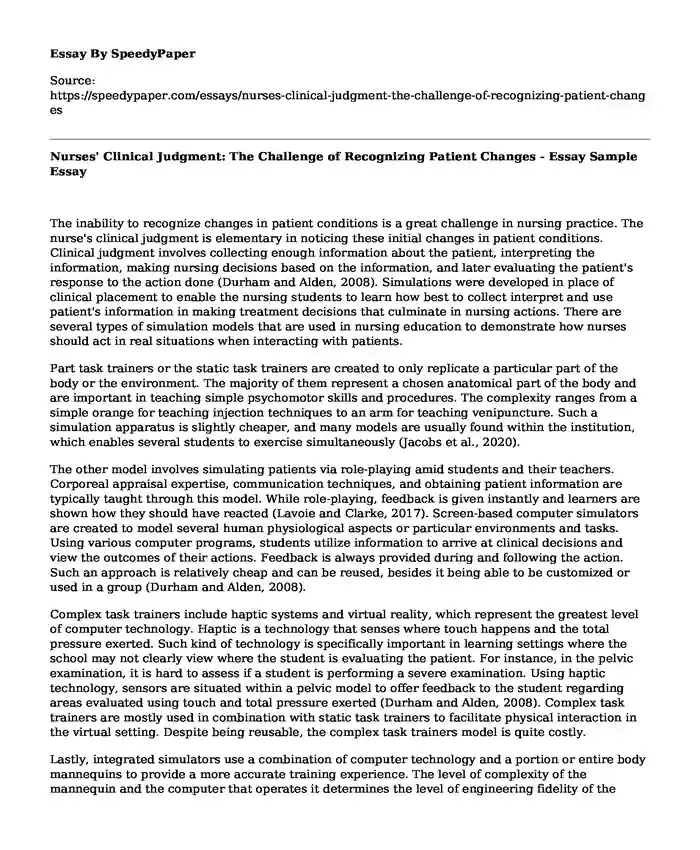
| Type of paper: | Essay |
| Categories: | Nursing |
| Pages: | 3 |
| Wordcount: | 805 words |
The inability to recognize changes in patient conditions is a great challenge in nursing practice. The nurse's clinical judgment is elementary in noticing these initial changes in patient conditions. Clinical judgment involves collecting enough information about the patient, interpreting the information, making nursing decisions based on the information, and later evaluating the patient's response to the action done (Durham and Alden, 2008). Simulations were developed in place of clinical placement to enable the nursing students to learn how best to collect interpret and use patient's information in making treatment decisions that culminate in nursing actions. There are several types of simulation models that are used in nursing education to demonstrate how nurses should act in real situations when interacting with patients.
Part task trainers or the static task trainers are created to only replicate a particular part of the body or the environment. The majority of them represent a chosen anatomical part of the body and are important in teaching simple psychomotor skills and procedures. The complexity ranges from a simple orange for teaching injection techniques to an arm for teaching venipuncture. Such a simulation apparatus is slightly cheaper, and many models are usually found within the institution, which enables several students to exercise simultaneously (Jacobs et al., 2020).
The other model involves simulating patients via role-playing amid students and their teachers. Corporeal appraisal expertise, communication techniques, and obtaining patient information are typically taught through this model. While role-playing, feedback is given instantly and learners are shown how they should have reacted (Lavoie and Clarke, 2017). Screen-based computer simulators are created to model several human physiological aspects or particular environments and tasks. Using various computer programs, students utilize information to arrive at clinical decisions and view the outcomes of their actions. Feedback is always provided during and following the action. Such an approach is relatively cheap and can be reused, besides it being able to be customized or used in a group (Durham and Alden, 2008).
Complex task trainers include haptic systems and virtual reality, which represent the greatest level of computer technology. Haptic is a technology that senses where touch happens and the total pressure exerted. Such kind of technology is specifically important in learning settings where the school may not clearly view where the student is evaluating the patient. For instance, in the pelvic examination, it is hard to assess if a student is performing a severe examination. Using haptic technology, sensors are situated within a pelvic model to offer feedback to the student regarding areas evaluated using touch and total pressure exerted (Durham and Alden, 2008). Complex task trainers are mostly used in combination with static task trainers to facilitate physical interaction in the virtual setting. Despite being reusable, the complex task trainers model is quite costly.
Lastly, integrated simulators use a combination of computer technology and a portion or entire body mannequins to provide a more accurate training experience. The level of complexity of the mannequin and the computer that operates it determines the level of engineering fidelity of the system. Fidelity is the level at which the look and abilities of the simulator liken the look and function of the simulated system. Human simulators are thus grouped into low, intermediate, and high fidelity systems. Low fidelity involves simulated physiology and anatomy, medium-fidelity involves computer-directed scenarios that respond as programmed, while high fidelity consists of computer-guided physiologically based that respond to interventions in real-time. The high fidelity model has several advantages such as enhancing the capability to evaluate variations in patient responses and students' capability to acquire significant appraisal information, increasing competency and capability to create a strategy for a particular circumstance, preparing students for clinical practice, and improving the organization of patients care. It also facilitates the practice of communication with multidisciplinary teams, teamwork, and leadership skills (Durham and Alden, 2008). Additionally, it enables communication, psychomotor, and delegation expertise to be streamlined. Conversely, high fidelity model has various limitations that include anxiety of the student affecting performance, the need for corporeal space for simulation and related learning sessions, lack of knowledge during the simulation experience of students, and lack of interest by teachers to use simulation as the learning approach (Durham and Alden, 2008).
References
Durham, C. F., & Alden, K. R. (2008). Enhancing patient safety in nursing education through patient simulation. In Patient safety and quality: An evidence-based handbook for nurses. Agency for Healthcare Research and Quality (US). https://www.ncbi.nlm.nih.gov/books/NBK2628/
Jacobs, S., Taylor, C., Dixon, K., & Wilkes, L. (2020). The advantages and disadvantages of using High Fidelity Simulation as an environment to observe undergraduate nurses’ actions and their alignment with clinical judgement characteristics. Clinical Nursing Studies, 15-20. https://doi.org/10.5430/cns.v8n1p15
Lavoie, P., & Clarke, S. P. (2017). Simulation in nursing education. Nursing Management, 48(2), 16-17. https://www.nursingcenter.com/journalarticle?Article_ID=3972319&Journal_ID=54013&Issue_ID=3972259
Cite this page
Nurses' Clinical Judgment: The Challenge of Recognizing Patient Changes - Essay Sample. (2023, Oct 27). Retrieved from https://speedypaper.net/essays/nurses-clinical-judgment-the-challenge-of-recognizing-patient-changes
Request Removal
If you are the original author of this essay and no longer wish to have it published on the SpeedyPaper website, please click below to request its removal:
- Essay Example about Quality Patient Care
- Reflection Paper Sample on Nursing Managerial Leadership and Analysis
- Free Essay: Assessment in the Nursing Process
- Paper Example: Practicum Objectives
- Essay Example - Congestive Heart Failure (CHF)
- Essay Sample on Male Nurse Students in Maternity Ward
- Why Do Good? Paper Example
Popular categories




